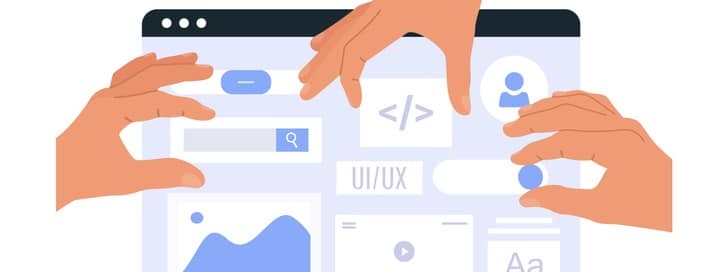In order for your website design to be the best it can possibly be, you’ll need to take into account numerous factors. One of the most important ones is your ideal customer.
No matter how functional or pretty you believe your website to be, if your target audience disagrees, you won’t achieve your desired results.
Let’s look at eight tips for incorporating design elements that will match your audience’s needs. We’ve also prepared some great examples of websites that have applied these tactics well.

Source: depositphotos.com
1) Help them choose the right product
One of the biggest challenges most of your website visitors will face is knowing which product or service is right for them. If you offer more than one, this will practically always be the case. No matter how well you write your descriptions, leads will need a bit of time to figure out what they need.
A great way to improve not only your website design but also your conversion rates is to lend them a hand. By incorporating a quiz, a product demonstration, or a complementary customer service consultation, you can help them make sure they have made the right choice.
This tactic will also reduce churn rate and customer complaints, and it will increase your retention rate.
FOCL has done a great job with their product finder quiz. It is quick and easy, and it makes selecting a product much easier. Since the brand sells products you might know nothing or very little about, this tactic can significantly boost their conversion rates.

Source: focl.com
2) Showcase your reviews and ratings
Incorporating social proof in your website design is another great way to improve user experience. It will make you more trustworthy and significantly improve your credibility. When customers and clients know someone else has already worked with you, they will place their own trust in you with more ease.
The key is to choose the right kind of social proof. Consider what your ideal customer is like. What are their pain points? What problems are they trying to solve?
Also consider demographic and lifestyle factors. For example, if you are targeting small business owners, branding about working with Fortune 500 companies won’t be as effective as you might have hoped. Instead, make sure to mention you have worked with brands similar to theirs.
Lanteria does a great job of incorporating various types of social proof on their website. First, they highlight the ratings they accumulated across various trusted platforms, like Capterra and Trustpilot.

Source: lanteria.com
They then also list the companies they have worked with, including some major brands. Finally, they also showcase testimonials from individual customers, highlighting specific aspects of their solutions.
3) Highlight key information in the header
Your customers will want to know as much about you as they possibly can in as little time as possible. They may be wondering whether your brand is legitimate, how they can reach you, what sets you apart from others, and so on.
A great design tactic to utilize is to feature some key information in the header section of your homepage. Aim to alleviate some common obstacles. For example, you may tell your visitors how much they need to spend in order to qualify for free shipping.
Think of the information that is most likely to make a tangible difference. For example, Sokisahtel has listed the amount you need to spend to qualify for free delivery. They also shared their customer service number and the working hours of their support team.

Source: sokisahtel.net
This information will ensure potential customers feel more at ease when shopping with them, as they know there is a human being they can reach out to in case they have any questions or concerns about making a purchase.
4) Foster a community
Creating a strong community is another great way to not only design a great website but also inspire more engagement and loyalty in your ideal customers.
You can do this by setting up a loyalty program, where customers will earn points they can later spend on your products. However, this is still rather a contactless club, where members don’t get to talk to each other.
Instead, you can also create an online group or club. Think of it as a place where your target audience can chat, get to know each other, and share their thoughts and experiences. It can also be a place where you share expertise and experience.
Love the Night Sky, for example, has a virtual astronomy club. They use it to send their audience detailed guides in the field and teach them how to improve their stargazing skills.
The fact that the club is exclusive and the newsletter features information that’s not a part of the website is a great way to play with a bit of FOMO and ensure a lot of amateur astronomers sign up.

Source: lovethenightsky.com
5) Include a short video
While writing detailed and informative copy should certainly be a part of your engagement and conversion strategy, you also need to make sure to cater to those members of your audience who don’t want to spend too much time reading.
Adding a short video to your landing pages can do the trick nicely. For one, it will ensure that all of your ideal customers can access a content format they prefer. It will also help you rank better, as search engines tend to prefer pages that offer more than just written content.
You can also use this video on social media, make it a part of your sales pitches, and find all kinds of uses for it.
SDVH, for example, showcases a neat video on their homepage. It gives a short overview of the business and the type of vehicles you can lease. It also lists the benefits of renting a car, which helps their target audience overcome any potential conversion obstacles.
You can film other types of videos as well. For example, a how-to video or a demo can also work very well, depending on the nature of your product.
6) Provide an instant conversion opportunity
Some of your customers will want to convert as soon as possible. Or, at the very least, they will want to see what conversion options you offer.
If you place your CTAs lower on the page, you will make them scroll unnecessarily. This may send some of your visitors back to the SERP.
Take a look at what eSkilled has done. Their entire homepage header is devoted to providing instant conversion opportunities. They immediately ask you to choose the product you are interested in and tell you who that specific product is for.

Source: eskilled.com.au
This is an especially important tactic if you have lots of different ideal customers. For example, if you work with both small businesses and large enterprises, you want them to know this is the case as soon as they land on your website.
7) List multiple (sub)categories
In order to improve user experience and truly design a website with your ideal customer in mind, you will need to devote quite a bit of time to figuring out the best website architecture and navigation.
This is especially important for large websites that carry a lot of products in different categories. You may create a mega menu that spans the entire page, but that still may not be enough to showcase all the subcategories of your products.
A good way to solve this issue is what Gear4Music did. Their menu is vast and features all their major product categories, which are further sliced in numerous ways. For example, if you’re looking to buy a guitar, you can browse by brand or by skill level, and you can quickly find all the accompanying gear.

Source: gear4music.com
They also apply the same principle to their product category pages. Sticking to our guitar example, when you click on this category, you can immediately decide whether you want to browse acoustic, electric, bass, or folk instruments.
8) Offer numerous filtering options
Finally, let’s touch upon another important website search and architecture feature: filters.
If you sell lots of products that fall under the same category but the products are vastly different, you’ll want to make it as easy as possible for your visitors to find exactly what they’re looking for. Vague filters won’t cut it. If they have to spend more than a couple of minutes looking for a product, chances are your potential customers will give up and go elsewhere.
Instead, try to think of different ways to categorize items. Do they differ in size, color, material, use, length of warranty? Create all of these filters to ensure customers can easily search your website.
SohoMod did a great job. For example, you can browse their coffee tables by brand, style, and shape. You can also set a pricing filter and only look at items that are currently available. Color and material filters are also available, practically guaranteeing that you’ll find just the coffee table you were looking for.

Source: sohomod.com
Wrapping up
Which of these tips and examples do you like the most? Have you incorporated any of them in your website design already?
Before you make any significant changes, remember to take into account your brand’s identity and the needs of your target audience. That will ensure that you come up with the best possible solutions.








